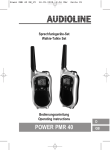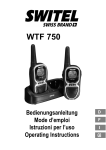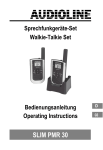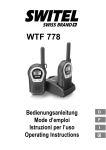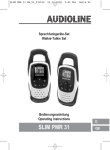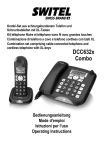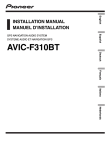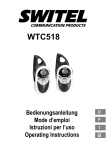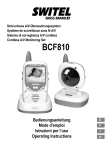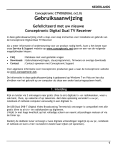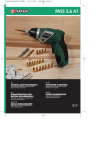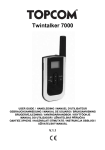Download WTF 729 - Switel
Transcript
Walkie − Talkie Set Kit talkie−walkie Set di walkie−talkie WTF 729 Walkie−talkie set Bedienungsanleitung Mode d’emploi Istruzioni per l’uso Operating Instructions Bedienungsanleitung . . . . . . 3 Mode d’emploi . . . . . . . . . . 21 Istruzioni per l’uso . . . . . . . 39 Operating Instructions . . . . . 57 Declaration of Conformity . . 76 2 1 Inhaltsverzeichnis 1 2 3 4 5 6 7 8 9 Sicherheitshinweise . . . . . . . . . . . . Funkgeräte in Betrieb nehmen . . . . Bedienelemente . . . . . . . . . . . . . . Menüstruktur . . . . . . . . . . . . . . . . . Wie bediene ich meine Funkgeräte? Falls es Probleme gibt . . . . . . . . . . Technische Eigenschaften . . . . . . . Pflegehinweise / Garantie . . . . . . . Stichwortverzeichnis . . . . . . . . . . . 4 5 7 8 9 16 17 18 19 3 Sicherheitshinweise 1 Sicherheitshinweise Lesen Sie diese Bedienungsanleitung sorgfältig durch. Bestimmungsgemäße Verwendung Diese Funkgeräte sind geeignet für die Kommunikation mit anderen Funkgeräten gleichen Standards. Jede andere Verwendung gilt als nicht bestimmungsgemäß. Eigenmächtige Veränderungen oder Umbauten sind nicht zulässig. Öffnen Sie die Geräte in keinem Fall selbst und führen Sie keine eigenen Reparaturversuche durch. Aufstellungsort Vermeiden Sie Belastungen durch Rauch, Staub, Erschütterungen, Chemikalien, Feuchtigkeit, Hitze oder direkte Sonneneinstrahlung. Verwenden Sie das Gerät nicht in explosionsgefährdeten Bereichen. Netzteil Achtung: Verwenden Sie nur das mitgelieferte Steckernetzteil, da andere Netzteile die Geräte beschädigen können. Sie dürfen den Zugang zum Steckernetzteil nicht durch Möbel oder andere Gegenstände versperren. Aufladbare Akkus Achtung: Werfen Sie Akkus nicht ins Feuer. Verwenden Sie nur Akkus des gleichen Typs! Achten Sie auf die richtige Polung! Bei verkehrter Polung der Akkus besteht beim Aufladen Explosionsgefahr. Medizinische Geräte Achtung: Benutzen Sie die Funkgeräte nicht in der Nähe von medizinischen Geräten. Eine Beeinflussung kann nicht völlig ausgeschlossen werden. Funkgeräte können in Hörgeräten einen unangenehmen Brummton verursachen. 4 Funkgeräte in Betrieb nehmen Entsorgung Wollen Sie Ihr Gerät entsorgen, bringen Sie es zur Sammelstelle Ihres kommunalen Entsorgungsträgers (z. B. Wertstoffhof). Das nebenstehende Symbol bedeutet, dass Sie das Gerät auf keinen Fall in den Hausmüll werfen dürfen! Nach dem Elektro− und Elektronikgerätegesetz sind Besitzer von Altgeräten gesetzlich gehalten, alte Elektro− und Elektronikgeräte einer getrennten Abfallerfassung zuzuführen. Akkus entsorgen Sie beim batterievertreibenden Handel sowie bei zuständigen Sammelstellen, die entsprechende Behälter bereitstellen. Verpackungsmaterialien entsorgen Sie entsprechend den lokalen Vorschriften. 2 Funkgeräte in Betrieb nehmen Sicherheitshinweise Achtung: Lesen Sie vor der Inbetriebnahme unbedingt die Sicherheitshinweise in Kapitel 1. Verpackungsinhalt prüfen Zum Lieferumfang gehören: − zwei Funkgeräte − ein Netzteil − zwei Akkupacks − eine Bedienungsanleitung Akkupack einlegen Öffnen Sie das Akkufach. Legen Sie das mitgelieferte Akkupack ein. Achten Sie auf die richtige Polung! Schließen Sie das Akkufach. Funkgeräte aufladen Schließen Sie das Netzteil an die Funkgeräte an. Verwenden Sie aus Sicherheitsgründen nur das mitgelieferte Netzteil. Alternativ können Sie die Funkgeräte auch über die USB−Schnittstelle eines PCs laden. Verwenden Sie hierfür ein handelsübliches Mini−USB−Kabel. Der PC muss für den Ladevorgang eingeschaltet sein. 5 Funkgeräte in Betrieb nehmen Laden Sie die Funkgeräte vor der ersten Inbetriebnahme für mindestens 10 Stunden. Verwenden Sie das Netzteil mit der Nr. KEAD−179−U oder DV−530UP und den Ausgangsdaten 5 V, 150 mA. Laden Sie die Funkgeräte nicht mit fremden Aufladegeräten. Für eine optimale Lebensdauer des Akkupacks beenden Sie den Ladevorgang, wenn Ihr Funkgerät vollständig geladen ist. Der aktuelle Akkuladezustand wird im Display angezeigt: voll halb schwach leer Sobald die Anzeige im Display blinkt, muss das Funkgerät aufgeladen werden. 6 Bedienelemente 3 Bedienelemente Die Merkmale und Funktionen Ihres Funkgeräts sind in den untenstehenden Abbildungen dargestellt. Die Tasten werden in dieser Bedienungsanleitung nachfolgend mit vereinheitlichten umrandeten Symbolen dargestellt. Leichte Abweichungen der Tastensymbole Ihres Geräts gegenüber den hier verwendeten Tastensymbolen sind daher möglich. Funkgerät 1 Display 2 Lautstärke erhöhen Einstellung aufwärts 3 Monitor O Kanalsuche 4 Gerät Ein / Aus 5 Lautstärke verringern Einstellung abwärts 6 Lautsprecher 7 Headset−Buchse 8 USB−Ladebuchse 9 Menü Tastensperre 10 Rufton senden 11 Mikrofon 12 PTT−Taste 13 LED Betriebsanzeige 1 13 12 2 11 3 10 9 4 5 6 8 7 7 Menüstruktur Display 1 2 3 4 5 6 7 Bestätigungston aktiviert (Roger Beep) CTCSS1−/CDCSS2−Code VOX−Mode aktiviert Kanalanzeige Akkukapazitätsanzeige Tastensperre aktiviert 6 Kanalsuche aktiviert 7 5 1 2 4 3 4 Menüstruktur Menü 2 In den Einstellungsmodus gelangen Sie, wenn Sie die Taste drücken. Danach wählen Sie mit den Tasten / einen Eintrag aus und bestätigen Ihre Auswahl mit der Taste . 1x Kanal wählen 2x CTCSS−/CDCSS−Code wählen 3x Rufton 0 (= Aus) − 10 wählen 4x VOX−/iVOX−Empfindlichkeitsstufe wählen 5x Automatische Abschaltung wählen (nach 30, 60 oder 90 Minuten) 1 CTCSS: Continous Tone Coded Squelch System = Selektivruf 2 CDCSS: Continous Digital Coded Squelch System = Selektivruf 8 Wie bediene ich meine Funkgeräte? 5 Wie bediene ich meine Funkgeräte? Darstellungsweise in der Bedienungsanleitung Abgebildete Taste drücken Abgebildete Taste gedrückt halten Abgebildete Taste loslassen ON Displayanzeige In das Mikrofon sprechen Funkgeräte ein− / ausschalten 3 Funkgerät einschalten Im Display werden alle zur Verfügung stehenden Displaysymbole kurz angezeigt. Anschließend werden der zuletzt eingestellte Kanal und die Rufcodierung angezeigt. Funkgerät ausschalten Sollten Sie das Funkgerät längere Zeit nicht benutzen, empfehlen wir das Akkupack zu entnehmen. Lautstärkeregelung / lauter oder leiser Senden und Empfangen Senden 4 Wenn Sie die Taste drücken, leuchtet die rote LED. Wird die Taste länger als 60 Sekunden gedrückt, ertönt ein Warnton. Die Übertragung wird unterbrochen. , Senden Halten Sie das Funkgerät ca. 5−7 cm vom Mund entfernt und sprechen Sie mit normaler Lautstärke. Um mit anderen Teilnehmern zu sprechen, müssen alle Funkgeräte auf den gleichen Kanal und die gleiche Rufcodierung eingestellt sein. Empfangen 5 Empfangen 9 Wie bediene ich meine Funkgeräte? Sie können keine Funksignale empfangen, wenn Sie die Taste gedrückt halten. Kanalwahl PMR446 (Private Mobil Radio)−Funkgeräte können überall in Europa anmelde− und gebührenfrei benutzt werden. Es sind 8 Funkkanäle im Frequenzbereich von 446.000 MHz bis 446.100 MHz freigegeben. 1 x , /, Kanal auswählen und bestätigen Jeder Vorgang wird automatisch abgebrochen, wenn innerhalb von 5 Sekunden keine Einstellung erfolgt. Kanal Frequenz (MHz) Kanal Frequenz (MHz) 1 446.00625 5 446.05625 2 446.01875 6 446.06875 3 446.03125 7 446.08125 4 446.04375 8 446.09375 CTCSS1/ CDCSS2−Code (Rufcodierungen) wählen Es stehen 38 analoge (CTCSS 1 − 38) und 83 digitale (CDCSS 39 − 121) Codierungen je Kanal zur Verfügung. Funkteilnehmer können nur miteinander kommunizieren, wenn Funkkanal und Rufcodierung an den Geräten übereinstimmen. Die Rufcodierung wird als nicht hörbares Signal mit der normalen Sprachnachricht mitgesendet. Bei dem Empfänger wird die Sprache nur dann auf den Lautsprecher übertragen, wenn der eingestellte Kanal und die Rufcodierung mit den empfangenen Daten (Einstellungen am Sender) identisch sind. Sollte zufälligerweise auf demselben Kanal ein anderer Teilnehmer dieselbe Rufcodierung verwenden, wechseln Sie bitte mit Ihrem Gespächspartner auf einen freien Kanal. 1 CTCSS: Continous Tone Coded Squelch System = Selektivruf 2 CDCSS: Continous Digital Coded Squelch System = Selektivruf 10 Wie bediene ich meine Funkgeräte? 2 x , /, Rufcodierung auswählen und bestätigen Eine Ausnahme ist die Rufcodierung 0 (Null). Bei dieser Einstellung können alle Gespräche auf dem eingestellten Kanal gehört werden. Um am Funkverkehr teilnehmen zu können, müssen Sie dann die entsprechende Rufcodierung einstellen. Monitor Die Monitor−Funktion ermöglicht es Ihnen, auf dem aktuell eingestellten Kanal nach schwachen Signalen zu suchen. Wenn Sie ein fremdes Signal empfangen, wechseln Sie auf einen freien Kanal. Kommunizieren Sie mit anderen Teilnehmern immer auf einem freien Kanal, um Störungen zu vermeiden. Kanal abhören Abhören beenden VOX1 / iVOX2 (Freisprechen) Bei diesen Funktionen beginnt das Funkgerät automatisch zu senden, wenn Ihre Stimme oder ein Geräusch erkannt wird. Wenn Sie anfangen zu sprechen, tritt eine kurze Verzögerung auf, bevor das Funkgerät sendet. VOX−Modus aktivieren Beim Freisprechen im VOX−Modus wird über ein Headset gesprochen. Benutzen Sie ein handelsübliches Head3 2 set ohne PTT−Taste mit einem 3−poligen 1 2,5 mm Stereoklinkenstecker. Steckerbelegung: 1 = Lautsprecher 2 = Mikrofon 3 = Masse Schalten Sie das Funkgerät aus, bevor Sie ein Headset anschließen. 1 2 VOX: Voice Operated Transmission = Geräuscherkennung iVOX: Intelligent Voice Operated Transmission = Geräuscherkennung 11 Wie bediene ich meine Funkgeräte? 1. 2. 3. 4. Schalten Sie das Funkgerät aus. Stecken Sie den Stecker eines Headsets in die Anschlussbuchse. Schalten Sie das Funkgerät ein. Im Display wird VOX" angezeigt. VOX−Modus deaktivieren Um den VOX−Modus zu deaktivieren, ziehen Sie den Stecker des Headsets aus der Anschlussbuchse oder drücken Sie die Taste . iVOX−Modus aktivieren Beim Freisprechen im iVOX−Modus wird über das Funkgerät gesprochen. Die −Taste muss nicht gedrückt werden, um zu senden. 1. Schalten Sie das Funkgerät aus. 2. Drücken Sie die −Taste und halten Sie diese gedrückt. 3. Schalten Sie das Funkgerät ein. 4. Lassen Sie die −Taste los. 5. Im Display wird iVOX" angezeigt. iVOX−Modus deaktivieren Um den iVOX−Modus zu deaktivieren, schalten Sie das Funkgerät aus und erneut ein. VOX− / iVOX−Empfindlichkeit wählen Für den Betrieb im VOX− / iVOX−Modus können 3 Empfindlichkeitsstufen entsprechend der Umgebungsgeräusche gewählt werden. L1 L2 L3 laute Umgebungsgeräusche normale Umgebungsgeräusche leise Umgebungsgeräusche 4 x , /, 12 Empfindlichkeit auswählen und bestätigen Wie bediene ich meine Funkgeräte? Rufton senden Der Rufton macht andere Teilnehmer darauf aufmerksam, dass Sie ein Gespräch beginnen möchten. Voraussetzung dafür ist, dass die anderen Teilnehmer den gleichen Kanal und die gleiche Rufcodierung verwenden. Rufton senden Rufton wählen / ausschalten Sie haben 10 Ruftöne zur Auswahl. Um den Rufton auszuschalten, wählen Sie die Einstellung 0" (Null). 3 x , /, Rufton auswählen und bestätigen Kanalsuche In einer Endlosschleife wird auf den acht Kanälen nach Signalen ge−Symbol angezeigt. Wird ein aktiver sucht. Im Display wird das Kanal gefunden, stoppt die Kanalsuche. Drücken Sie die Taste , um am Funkverkehr teilzunehmen. Wenn Sie die Taste nicht drücken, wird die Kanalsuche nach fünf Sekunden fortgesetzt. Globale Kanalsuche starten / beenden Stellen Sie die Rufcodierung des Ausgangskanals auf 0 (Null), um die Globale Kanalsuche" durchzuführen. Der Suchlauf stoppt bei jedem Kanal, auf dem ein Signal empfangen wird, unabhängig davon, mit welcher Rufcodierung dieses Signal gesendet wird. O Kanalsuche starten / beenden Gezielte Kanalsuche starten / beenden Stellen Sie die Rufcodierung von jedem Kanal auf einen individuellen Wert, um die Gezielte Kanalsuche" durchzuführen. Der Suchlauf stoppt nur, wenn ein Signal auf einem Kanal empfangen wird, das mit dem eingestellten Wert übereinstimmt. O Kanalsuche starten / beenden Wenn bei Gezielte Kanalsuche" ein gewünschter Kanal komplett durchsucht werden soll, ist für diesen Kanal die Rufcodierung auf 0 (Null) zu stellen. Kanalsuche fortsetzen / Kanalsuche fortsetzen 13 Wie bediene ich meine Funkgeräte? Kanal 6 ausschließen Wenn ein gefundener Kanal von der Kanalsuche nicht weiter berücksichtigt werden soll, dann können Sie diesen ausschließen. Halten Sie die Taste / für 3 Sekunden gedrückt. Beim Start einer neuen Kanalsuche werden wieder alle Kanäle berücksichtigt. , 3 Sek. / Kanal wird ausgeschlossen und Kanalsuche wird automatisch fortgesetzt Bestätigungston Der Bestätigungston erklingt, wenn Sie die Taste loslassen. Dadurch wird Ihrem Gesprächspartner signalisiert, dass Ihre Übertragung beendet ist. Bestätigungston 7 ein−/ausschalten 1. 2. 3. 4. Schalten Sie das Funkgerät aus. Drücken Sie die −Taste und halten Sie diese gerückt. Schalten Sie das Funkgerät ein. Lassen Sie die −Taste los. 5. Im Display wird angezeigt. Tastensperre Die Tastensperre verhindert das ungewollte Ändern von Ein− −Symbol stellungen. Bei eingeschalteter Tastensperre wird das im Display angezeigt. Aktivieren 8 3 Sek. Tastensperre aktivieren Deaktivieren 9 3 Sek. Tastensperre deaktivieren Displaybeleuchtung Die Displaybeleuchtung wird durch die Betätigung jeder beliebigen Taste eingeschaltet. Ausnahmen sind die Tasten und . Die Beleuchtung wird für ca. 5 Sekunden eingeschaltet. 14 Wie bediene ich meine Funkgeräte? Headset 10 Benutzen Sie nur zugelassene Headsets. Wenn das Headset über eine zusätzliche PTT−Taste verfügt, können Sie über diese senden. Schalten Sie das Funkgerät aus, bevor Sie ein Headset anschließen. 1. Schalten Sie das Funkgerät aus. 2. Stecken Sie den Stecker des Headsets in die Anschlussbuchse. 3. Schalten Sie das Funkgerät ein. Verwenden Sie das Gerät nur mit zugelassenen Headsets. Bei Verwendung anderer Headsets kann eine Beschädigung der Geräte/Headsets nicht ausgeschlossen werden. Automatische Abschaltung Sie können Ihre Funkgeräte so einstellen, dass sie nach Ablauf einer bestimmten Zeit ausgeschaltet werden. Sie können 30, 60 oder 90 Minuten einstellen. Die Funktion ist deaktiviert, wenn Sie die Einstellung 0" ausgewählt haben. 5 x , /, Zeit auswählen und bestätigen 15 Falls es Probleme gibt 6 Falls es Probleme gibt Haben Sie Probleme mit Ihrem Funkgerät, kontrollieren Sie zuerst die folgenden Hinweise. Bei technischen Problemen können Sie sich an unsere Service−Hotline unter Tel. 0900 00 1675 innerhalb der Schweiz (Kosten Swisscom bei Drucklegung: CHF 2.60/min) wenden. Bei Garantieansprüchen wenden Sie sich an Ihren Fachhändler. Die Garantiezeit beträgt 2 Jahre. Fragen und Antworten 16 Fragen Antworten Keine Funktion − Funkgerät nicht geladen − Tastensperre aktiviert Senden nicht möglich − Taste zum Senden gedrückt halten − Kanal wird von anderen Teilnehmern benutzt Kein Empfang − Taste loslassen − Lautstärke zu gering eingestellt − Sie befinden sich außerhalb des Empfangsbereichs, ändern Sie Ihre Position − Hindernisse wie Bäume und Gebäude haben einen negativen Einfluss auf die Reichweite − Rufcodierung ist nicht identisch mit dem des Gesprächspartners − Kanal wird von anderen Teilnehmern benutzt − Während des Aufladens kann Ihr Funkgerät nicht senden oder empfangen. − Akkuladezustand zu gering Technische Eigenschaften 7 Technische Eigenschaften Technische Daten Merkmal Wert Ausgangsleistung 0.5 W Reichweite ca. 5 km − bei freier Sichtlinie Stand−by−Zeit Bis zu 12 Std. (5% senden, 5% empfangen, 90% Stand−by) Max. Gesprächsdauer Bis zu 36 Min. Ladezeit bei Erstbetrieb Min. 10 Std. Ladezeit Min. 10 Std. Akkupack 3,7 V Li−ion Akku, 680 mAh Stromversorgung Eingang: 230 V, 50 Hz Ausgang: 5 V, 150 mA Konformitätserklärung Dieses Gerät erfüllt die Anforderungen der EU−Richtlinie: 1999/5/EG Richtlinie über Funkanlagen und Telekommunikationsendeinrichtungen und die gegenseitige Anerkennung ihrer Konformität. Die Konformität mit der o. a. Richtlinie wird durch das CE−Zeichen auf dem Gerät bestätigt. 17 Pflegehinweise / Garantie 8 Pflegehinweise / Garantie Pflegehinweise Reinigen Sie die Gehäuseoberflächen mit einem weichen und fusselfreien Tuch. Verwenden Sie keine Reinigungsmittel oder Lösungsmittel. Garantie SWITEL Geräte werden nach den modernsten Produktionsverfahren hergestellt und geprüft. Ausgesuchte Materialien und hoch entwikkelte Technologien sorgen für einwandfreie Funktion und lange Lebensdauer. Die Garantie gilt nicht für die in den Produkten verwendeten Batterien, Akkus oder Akkupacks. Die Garantiezeit beträgt 24 Monate, gerechnet vom Tage des Kaufs. Innerhalb der Garantiezeit werden alle Mängel, die auf Material− oder Herstellungsfehler zurückzuführen sind, kostenlos beseitigt. Der Garantieanspruch erlischt bei Eingriffen durch den Käufer oder durch Dritte. Schäden, die durch unsachgemäße Behandlung oder Bedienung, natürliche Abnutzung, durch falsches Aufstellen oder Aufbewahren, durch unsachgemäßen Anschluss oder Installation sowie durch höhere Gewalt oder sonstige äußere Einflüsse entstehen, fallen nicht unter die Garantieleistung. Wir behalten uns vor, bei Reklamationen die defekten Teile auszubessern, zu ersetzen oder das Gerät auszutauschen. Ausgetauschte Teile oder ausgetauschte Geräte gehen in unser Eigentum über. Schadenersatzansprüche sind ausgeschlossen, soweit sie nicht auf Vorsatz oder grober Fahrlässigkeit des Herstellers beruhen. Sollte Ihr Gerät dennoch einen Defekt innerhalb der Garantiezeit aufweisen, wenden Sie sich bitte unter Vorlage Ihrer Kaufquittung ausschließlich an das Geschäft, in dem Sie Ihr SWITEL Gerät gekauft haben. Alle Gewährleistungsansprüche nach diesen Bestimmungen sind ausschließlich gegenüber Ihrem Fachhändler geltend zu machen. Nach Ablauf von zwei Jahren nach Kauf und Übergabe unserer Produkte können Gewährleistungsrechte nicht mehr geltend gemacht werden. 18 Stichwortverzeichnis 9 Stichwortverzeichnis A Akkupack einlegen, 5 Aufladen, 5 Ausschalten, 9 Automatische Abschaltung, 15 B Bedienelemente, 7 Bedienung, 9 Bestätigungston, 14 C CTCSS/CDCSS−Code, 10 D Display, 8 Displaybeleuchtung, 14 E Einschalten, 9 Empfangen, 9 F Fehlerbehebung, 16 Fragen, 16 G Garantie, 18 Gezielte Kanalsuche, 13 Globale Kanalsuche, 13 H Headset, 15 I Inbetriebnahme, 5 iVOX (Freisprechen), 11 K Kanal ausschließen, 14 Kanalsuche, 13 Kanalwahl, 10 Konformitätserklärung, 17 L Laden, 5 Lautstärkeregelung, 9 M Menüstruktur, 8 Monitor, 11 P Pflegehinweise, 18 R Rufcodierung, 10 Rufton, 12 Rufton wählen / ausschalten, 13 S Senden, 9 Sicherheitshinweise, 4 Steckerbelegung, 11 T Tastensperre, 14 Technische Daten, 17 U Umgebungsgeräusche, 12 V Verpackungsinhalt, 5 VOX (Freisprechen), 11 19 Notizen Notizen 20 11 Table des matières 1 Consignes de sécurité . . . . . . . . . . 2 Mettre les émetteurs−récepteurs en service . . . . . . . . . . . . . . . . . . . 3 Eléments de manipulation . . . . . . . 4 Structure de menu . . . . . . . . . . . . . 5 Comment utiliser l’émetteur−récepteur ? . . . . . . . . . . 6 En cas de problèmes . . . . . . . . . . . 7 Caractéristiques techniques . . . . . . 8 Remarques d’entretien / Garantie . . 9 Index . . . . . . . . . . . . . . . . . . . . . . 22 23 25 26 27 34 35 36 37 21 Consignes de sécurité 1 Consignes de sécurité Lisez très attentivement ce mode d’emploi. Utilisation conforme aux prescriptions Ces émetteurs−récepteurs conviennent pour la communication avec d’autres émetteurs−récepteurs de même standard. Toute autre utilisation est considérée comme non conforme à l’usage. Des modifications ou changements effectués d’un propre gré ne sont pas autorisés. N’ouvrez en aucun cas les appareils et n’effectuez aucun essai de réparation vous−même. Lieu d’installation Evitez toute nuisance par la fumée, la poussière, les tremblements, les produits chimiques, l’humidité, la grande chaleur ou l’ensoleillement direct. Ne vous servez pas de l’appareil dans des endroits exposés aux explosions. Bloc secteur Attention:N’utilisez que le bloc d’alimentation enfichable fourni avec l’appareil, d’autres pouvant détruire les appareils. Vous ne devez pas bloquer son accès par des meubles ou d’autres objets. Piles rechargeables Attention : Ne jetez pas les piles dans le feu. N’utilisez que des piles rechargeables du même type ! Observez une polarisation correcte ! Risque d’explosion lors de leur chargement si la polarisation est incorrecte. Appareils médicaux 22 Attention : N’utilisez pas ces émetteurs−récepteurs à proximité d’appareils médicaux, leur influence sur ceux− ci ne pouvant pas être totalement exclue. Les émetteurs− récepteurs peuvent causer un bourdonnement désagréable dans les prothèses auditives. Mettre les émetteurs−récepteurs en service Élimination Si vous ne voulez plus vous servir de votre appareil, veuillez l’apporter au centre de collecte de l’organisme d’élimination des déchets de votre commune (par ex. centre de recyclage). L’icône ci−contre signifie que vous ne devez en aucun cas jeter votre appareil dans les ordures ménagères ! D’après la loi relative aux appareils électriques et électroniques, les propriétaires d’appareils usagés sont tenus de mettre tous les appareils électriques et électroniques usagés dans un collecteur séparé. Éliminez les piles rechargeables auprès d’un revendeur spécialisé ainsi que dans des centres de collecte qui tiennent à votre disposition les collecteurs appropriés. Éliminez les fournitures d’emballage conformément aux prescriptions locales. 2 Mettre les émetteurs−récepteurs en service Consignes de sécurité Attention : Avant de mettre votre appareil en service, lisez impérativement les consignes de sécurité mentionnées au chapitre 1. Contrôler le contenu de l’emballage Les éléments suivants font partie de la livraison : − deux émetteurs−récepteurs − deux packs de piles rechargeables − un bloc secteur − un mode d’emploi Mettre en place le pack de piles rechargeables Ouvrez le compartiment à piles. Insérez dedans le compartiment à piles le pack de piles rechargeables fourni avec l’appareil. Observez une polarisation correcte ! Fermez le compartiment à piles. 23 Mettre les émetteurs−récepteurs en service Charger les émetteurs−récepteurs Raccordez le bloc secteur aux émetteurs−récepteurs. Pour des raisons de sécurité, n’utilisez que le bloc secteur fourni avec l’appareil. Vous pouvez également charger les émetteurs−récepteurs via l’interface USB d’un PC. Vous devez alors utiliser un câble USB/Mini en vente dans le commerce. Allumez votre PC pour le chargement. Avant la première mise en service, chargez les émetteurs−récepteurs pendant un minimum de 10 heures. Utilisez le bloc secteur portant le n° KEAD−179−U ou DV−530UP et les données de sortie 5 V, 150 mA. Ne chargez pas les émetteurs−récepteurs avec des chargeurs d’un autre fabricant. Pour une durée de vie optimale du pack de piles rechargeables, mettez fin à l’opération de chargement quand votre émetteur−récepteur est entièrement rechargé. Le niveau actuel de chargement des piles est affiché sur l’écran : Plein 24 Moyen Faible Vide Dès que l’affichage clignote à l’écran, l’émetteur−récepteur doit être rechargé. Eléments de manipulation 3 Eléments de manipulation Les caractéristiques et les fonctions de votre émetteur−récepteur sont représentées par les illustrations ci−dessous. Dans ce mode d’emploi, les touches seront représentées dans ce qui suit par des icônes encadrées standardisées. De ce fait, il peut y avoir de légères différences entre les icônes des touches de votre appareil et celles utilisées ici. Émetteur−récepteur 1 Écran 2 Augmenter le volume 13 sonore Réglage plus fort 3 Écran O Recherche de canal 12 4 11 Appareil Marche/ Arrêt 5 10 Diminuer le volume sonore 9 Réglage moins fort 6 Haut−parleur 7 Prise de casque 8 Douille de chargement USB 9 Menu Verrouillage du clavier 10 Émission d’un signal d’appel 8 11 Microphone 12 Touche PTT 13 DEL Affichage de fonctionnement 1 2 3 4 5 6 7 25 Structure de menu Écran 1 2 3 4 5 6 7 Signal de confirmation activé (Roger Beep) Code CTCSS1−/CDCSS2 Mode VOX activé Affichage du canal Affichage de capacité des piles rechargeables Le verrouillage du clavier est activé 6 7 Recherche de canal activée 5 1 2 4 3 4 Structure de menu Menu 12 Vous accédez au mode de réglage en appuyant sur la touche M. Ensuite, sélectionnez un enregistrement avec les touches / et confirmez votre sélection avec la touche . 1x Sélectionner le canal 2x Sélectionner le code CTCSS−/CDCSS 3x Signal d’appel 0 (= Éteint) − Sélectionner 10 4x Sélectionner le degré de sensibilité VOX−/iVOX 5x Sélectionner le débranchement automatique (au bout de 30, 60 ou 90 minutes) 1 CTCSS: Continous Tone Coded Squelch System = Appel sélectif 2 CDCSS: Continous Digital Coded Squelch System = Appel sé- lectif 26 Comment utiliser l’émetteur−récepteur ? 5 Comment utiliser l’émetteur−récepteur ? Mode de représentation dans le mode d’emploi Appuyer sur la touche représentée Maintenir appuyée la touche représentée Relâcher la touche représentée ON Affichage de l’écran Parler dans le microphone Allumer / Éteindre les émetteurs−récepteurs 13 Allumer l’émetteur−récepteur Toutes les icônes d’écran disponibles sont rapidement affichées à l’écran. Ensuite, le canal réglé en dernier et le code d’appel s’affichent. Éteindre l’émetteur−récepteur Si vous deviez ne pas utiliser l’émetteur−récepteur pendant une période prolongée, nous vous recommandons de retirer le pack de piles rechargeables. Réglage du volume sonore / plus fort ou moins fort Émettre et recevoir Émettre 14 Lorsque vous appuyez sur la touche , la LED rouge s’allume. Si vous la maintenez appuyée la touche pendant plus de 60 secondes, un signal sonore d’avertissement se fait entendre. La transmission est interrompue. , , Émettre Tenez l’émetteur−récepteur à 5 −7 cm env. de votre bouche et parlez avec un volume sonore normal. Pour parler avec d’autres correspondants, tous les appareils doivent être réglés sur le même canal et sur le même code d’appel. 27 Comment utiliser l’émetteur−récepteur ? Recevoir 15 Recevoir Vous ne pouvez pas recevoir de signaux radio si vous maintenez la touche appuyée. Choix du canal Les émetteurs−récepteurs PMR446 (Private Mobil Radio) peuvent être utilisés partout en Europe sans être déclarés et sont exonérés de taxes. 8 canaux radio sont validés dans une gamme de fréquences de 446.000 MHz à 446.100 MHz. 1 x , /, Sélectionner le canal et confirmer Chaque opération est automatiquement interrompue si vous n’effectuez pas de réglage dans les 5 secondes. Canal Fréquence (MHz) Canal Fréquence (MHz) 1 446.00625 5 446.05625 2 446.01875 6 446.06875 3 446.03125 7 446.08125 4 446.04375 8 446.09375 Codes CTCSS1/ CDCSS2 Sélectionner les (codes d’appel) 38 codifications analogiques (CTCSS 1 − 38) et 83 numériques (CDCSS 39 − 121) sont disponibles par canal. Les utilisateurs radio ne peuvent communiquer les uns avec les autres que si le canal radio et le code d’appel des appareils concordent. 1 CTCSS: Continous Tone Coded Squelch System = Appel sélectif 2 CDCSS: Continous Digital Coded Squelch System = Appel sé- lectif 28 Comment utiliser l’émetteur−récepteur ? Le code d’appel est envoyé avec le message vocal normal sous la forme d’un signal inaudible. Chez le récepteur, la langue n’est transmise au haut−parleur que si le canal paramétré et le code d’appel sont identiques aux données reçues (réglages sur l’émetteur). Si, par hasard, un autre correspondant utilisait le même code d’appel sur le même canal, veuillez passer avec votre correspondant sur un autre canal libre. 2 x , /, Sélectionner le code d’appel et confirmer Une exception est le code d’appel 0 (zéro). Avec ce réglage, toutes les communications peuvent être entendues sur le canal paramétré. Pour pouvoir participer au contact radio, vous devez alors régler le code d’appel correspondant. Écran La fonction Écran vous permet de chercher des signaux faibles sur le canal actuellement paramétré. Si vous recevez un signal étranger, passez sur un canal libre. Communiquez toujours avec d’autres correspondants sur un canal libre pour éviter les perturbations. Écouter le canal Terminer l’écoute VOX1 / iVOX2 (mode mains−libres) Avec ces fonctions, l’émetteur−récepteur commence automatiquement à émettre s’il entend votre voix ou un bruit. Quand vous commencez à parler, un léger retardement se produit avant que l’émetteur−récepteur émette. Activer le mode VOX (mains libres) En parlant dans le mode VOX mains−libres, vous parlez via un kit d’oreilles. 1 2 VOX: Voice Operated Transmission = détection de bruits iVOX: Intelligent Voice Operated Transmission = détection de bruits 29 Comment utiliser l’émetteur−récepteur ? Utilisez un kit d’oreilles disponible dans le commerce sans touche PTT avec une fiche à jack tripolaire stéréo 2,5 mm. Affectation des plots de connexion: 1 = haut−parleur, 2 = microphone, 3 = terre 1 2 3 Débranchez l’émetteur−récepteur avant de raccorder votre casque. 1. Éteignez l’émetteur−récepteur. 2. Introduisez la fiche d’un kit d’oreilles dans la prise de raccordement. 3. Allumez l’émetteur−récepteur. 4. VOX" s’affiche à l’écran. Désactiver le mode VOX Pour désactiver le mode VOX, tirez la fiche du kit d’oreilles hors de la prise de raccordement ou appuyez sur la touche . Activer le mode iVOX En parlant mains−libres en mode iVOX, vous parlez via l’émetteur−récepteur. Vous n’avez pas besoin d’appuyer sur la touche pour émettre. 1. Éteignez l’émetteur−récepteur. 2. Appuyez sur la touche et maintenez−la appuyée. 3. Allumez l’émetteur−récepteur. 4. Relâchez la touche . 5. iVOX" s’affiche à l’écran. Désactiver le modeiVOX Pour désactiver le mode iVOX, débranchez et rebranchez l’émetteur− récepteur. 30 Comment utiliser l’émetteur−récepteur ? Sélectionner la sensibilité VOX / iVOX Pour le fonctionnement en mode VOX / iVOX, vous pouvez sélectionner 3 sensibilités en fonction des bruits ambiants. L1 L2 L3 Bruits ambiants forts Bruits ambiants normaux Bruits ambiants faibles 4 x , /, Sélectionner la sensibilité et confirmer Émettre un signal d’appel Le signal d’appel fait remarquer à d’autres correspondants que vous désirez entamer une conversation. À condition que les autres correspondants utilisent le même canal et le même code d’appel. Émission d’un signal d’appel Sélection / désactivation du signal d’appel Vous avez 10 signaux d’appel à votre disposition. Pour désactiver le signal d’appel, sélectionnez le paramétrage 0 (zéro). 3 x , /, Sélectionner le signal d’appel et confirmer Recherche du canal Dans une boucle infinie, l’appareil cherche des signaux sur les huit est affiché à l’écran : Si un canal actif est canaux. Le symbole − trouvé, la recherche du canal s’arrête. Appuyez sur la touche pour participer au contact radio. Si vous n’appuyez pas sur la touche , la recherche de canal se poursuivra au bout de cinq secondes. Démarrer / terminer la recherche globale de canal Réglez le code d’appel du canal de sortie sur 0 (zéro) pour effectuer la Recherche de canal globale". La recherche de canaux s’arrête à chaque canal sur lequel un signal est reçu, indépendamment du code d’appel avec lequel ce signal a été émis. O Démarrer / Terminer la recherche de canal Démarrer / Terminer la recherche ciblée de canal Réglez le code d’appel de chaque canal sur une valeur individuelle 31 Comment utiliser l’émetteur−récepteur ? pour effectuer la Recherche ciblée de canal". La recherche de canaux ne s’arrête que lorsqu’un signal est reçu sur un canal concordant avec la valeur réglée. O Démarrer / Terminer la recherche de canal Si vous désirez rechercher complètement un canal dans la fonction Recherche ciblée de canal", réglez le code d’appel de ce dernier sur 0 (zéro). Continuer la recherche de canal / Continuer la recherche de canal Exclure 16 un canal Si un canal trouvé ne doit plus être pris en compte dans la recherche de canal, vous pouvez alors exclure celui−ci. Maintenez la touche / appuyée pendant 3 secondes. Au départ d’une nouvelle recherche de canal, tous les canaux seront de nouveau pris en compte. , 3 sec. / Le canal est exclu et la recherche de canal se poursuit automatiquement. Signal de confirmation Le signal de confirmation retentit si vous relâchez la touche . Cela signale à votre correspondant que votre transmission est terminée. Activer 17 / Désactiver le signal de confirmation 1. 2. 3. 4. Éteignez l’émetteur−récepteur. Appuyez sur la touche et maintenez−la appuyée. Allumez l’émetteur−récepteur. Relâchez la touche . 5. Le symbole − s’affiche à l’écran. Verrouillage du clavier Le verrouillage du clavier empêche la modification involontaire de pa− ramétrages. Si le verrouillage du clavier est activé, le symbole s’affiche à l’écran. 32 Comment utiliser l’émetteur−récepteur ? Activer 18 3 sec. Activer le verrouillage du clavier Désactiver 19 3 sec. Désactiver le verrouillage du clavier Éclairage de l’écran L’éclairage de l’écran se branche à l’actionnement d’une touche quelconque. À l’exception des touches et . L’éclairage s’allume pendant env. 5 secondes. Casque 20 N’utilisez que le kit d’oreilles homologué. Si le kit d’oreilles dispose d’une touche supplémentaire PTT, vous pouvez émettre via celle−ci. Débranchez l’émetteur−récepteur avant de raccorder votre casque. 1. Éteignez l’émetteur−récepteur. 2. Introduisez la fiche du casque dans la prise de raccordement. 3. Allumez l’émetteur−récepteur. N’utilisez l’appareil qu’avec les casques autorisés. Si vous vous servez d’autres casques, un endommagement des appareils/casques ne peut pas être exclu. Débranchement automatique Vous pouvez programmer vos émetteurs−récepteurs de telle sorte qu’ils se débranchent au bout d’un temps déterminé. Vous pouvez programmer 30, 60 ou 90 minutes. La fonction est désactivée si vous avez sélectionné la programmation 0". 5 x , /, Sélectionner le temps et confirmer 33 En cas de problèmes 6 En cas de problèmes Si vous avez des problèmes avec votre émetteur−récepteur, contrôlez d’abord les points suivants. S’il s’agit de problèmes techniques, vous pouvez vous adresser à notre hotline de service en Suisse en appelant le numéro 0900 00 1675 (frais Swisscom à la date d’impression de ce manuel : CHF 2.60/min). Si vous jouissez de droits de garantie, adressez−vous à votre revendeur. La durée de la garantie est de 2 ans. Questions et réponses 34 Questions Réponses Pas de fonction − L’émetteur−récepteur n’est pas chargé − Le verrouillage du clavier est activé Émission pas possible − Maintenir la touche appuyée pour émettre − Le canal est utilisé par d’autres correspondants Pas de réception − Relâcher la touche − Le volume sonore est réglé trop faiblement − Vous vous trouvez en dehors de la zone desservie, modifiez votre position − Des obstacles, comme des arbres ou des bâtiments, exercent une influence négative sur la portée − Le code d’appel n’est pas identique à celui du correspondant − Le canal est utilisé par d’autres correspondants − Votre émetteur−récepteur ne peut ni émettre ni recevoir pendant le chargement. − Le niveau de chargement des piles est trop faible Caractéristiques techniques 7 Caractéristiques techniques Données techniques Caractéristique Valeur Puissance de sortie 0,5 W Portée Env. 5 km − si ligne visuelle libre Autonomie en veille Jusqu’à 12 heures (5% émission, 5% réception, 90% mode veille) Durée max. de communication Jusqu’à 36 min Temps de chargement lors de la première mise en service Min. 10 h Temps de chargement Min. 10 h Pack de piles rechargeables Pile rechargeable 3,7 V Li−ion, 680 mAh Alimentation en courant Entrée : 230 V, 50 Hz Sortie : 5 V, 150 mA Déclaration de conformité Cet appareil répond aux exigences des directives de l’union européenne (UE) : Directive 1999/5/CE sur les installations de radio et de télécommunication et la reconnaissance réciproque de leur conformité. La conformité avec la directive mentionnée ci−dessus est confirmée sur l’appareil par la marque CE. 35 Remarques d’entretien / Garantie 8 Remarques d’entretien / Garantie Remarques d’entretien Nettoyez les surfaces du boîtier avec un chiffon doux et non pelucheux. N’utilisez pas de produits d’entretien ou de solvants. Garantie Les appareilsSWITEL sont fabriqués et contrôlés selon les procédés les plus modernes. Des matériaux sélectionnés et des technologies de pointe ont pour effet un fonctionnement irréprochable et une longue durée de vie. La garantie n’est pas valable pour les piles, les piles rechargeables ou les packs de piles rechargeables utilisés dans les produits. La durée de la garantie est de 24 mois, à partir de la date d’achat. Pendant la durée de la garantie, tous les défauts dus à des vices de matériel ou de fabrication seront éliminés gratuitement. Le droit à la garantie expire en cas d’intervention de l’acheteur ou de tiers. Les dommages provenant d’un maniement ou d’une manipulation incorrects, d’une usure naturelle, d’une mauvaise mise en place ou d’une mauvaise conservation, d’un raccordement ou d’une installation incorrects ainsi que d’un cas de force majeure ou autres influences extérieures sont exclus de la garantie. En cas de réclamations, nous nous réservons le droit de réparer, de remplacer les pièces défectueuses ou d’échanger l’appareil. Les composants remplacés ou les appareils échangés deviennent notre propriété. Les demandes de dommages et intérêts sont exclues tant qu’elles ne reposent pas sur l’intention ou une négligence grossière du fabricant. Si votre appareil devait malgré tout présenter une défectuosité pendant la période de garantie, veuillez vous adressez, muni de la quittance d’achat, exclusivement au magasin où vous avez acheté votre appareil SWITEL. Tous les droits de garantie basés sur ces dispositions ne peuvent être revendiqués qu’auprès de votre revendeur. Deux ans après l’achat et la remise de nos produits, il n’est plus possible de faire valoir les droits à la garantie. 36 Index 9 Index A Affectation des plots de connexion, 30 Allumer, 27 B Bruits ambiants, 31 C Casque, 33 Charger, 24 Choix du canal, 28 Codes d’appel, 28 Consignes de sécurité, 22 Contenu de l’emballage, 23 CTCSS/CDCSS, 28 D Débranchement automatique, 33 Déclaration de conformité, 35 Données techniques, 35 E Éclairage de l’écran, 33 Écran, 26, 29 Eléments de manipulation, 25 Émettre, 27 Éteindre, 27 Exclure un canal, 32 G Garantie, 36 I iVOX (mode mains−libres), 29 M Manipulation, 27 Mettre en place le pack de piles rechargeables, 23 Mise en service, 23 Q Questions, 34 R Recevoir, 28 Recharger, 24 Recherche ciblée de canal, 31 Recherche du canal, 31 Recherche globale de canal, 31 Réglage du volume sonore, 27 Remarques d’entretien, 36 S Sélection / désactivation du signal d’appel, 31 Signal d’appel, 31 Signal de confirmation, 32 Structure de menu, 26 Suppression des erreurs, 34 V Verrouillage du clavier, 32 VOX (mode mains−libres), 29 37 Notes Notes 38 21 Contenuto 1 Indicazioni di sicurezza . . . . . . . . . 2 Messa in funzione dei radiotrasmettitori . . . . . . . . . . . . . . 3 Elementi di comando . . . . . . . . . . . 4 Struttura del menu . . . . . . . . . . . . . 5 Come funzionano i miei radiotrasmettitori? . . . . . . . . . . . . . 6 In presenza di problemi . . . . . . . . . 7 Specifiche tecniche . . . . . . . . . . . . 8 Consigli per la cura / Garanzia . . . . 9 Index . . . . . . . . . . . . . . . . . . . . . . 40 41 43 44 45 53 54 55 56 39 Indicazioni di sicurezza 1 Indicazioni di sicurezza Leggere attentamente le presenti istruzioni per l’uso. Impiego conforme agli usi previsti Questi radiotrasmettitori si prestano alla comunicazione con altri apparecchi radiotrasmettitori aventi lo stesso standard. Qualsiasi altro impiego è considerato come non conforme agli usi previsti. Non sono consentite modifiche o trasformazioni non autorizzate. Non aprire per nessuna ragione gli apparecchi autonomamente ed evitare di compiere riparazioni di propria iniziativa. Luogo di installazione Evitare un’esposizione a fumo, polvere, vibrazioni, sostanze chimiche, umidità, calore e raggi solari diretti. Non utilizzare l’apparecchio in aree esposte al rischio di deflagrazione. Alimentatore di rete Attenzione: Utilizzare esclusivamente l’alimentatore a spina fornito in dotazione visto che altri alimentatori di rete potrebbero addirittura danneggiare gli apparecchi. Non ostacolare il libero accesso all’alimentatore a spina con mobili o altri oggetti simili. Accumulatori ricaricabili Attenzione: Non gettare gli accumulatori ricaricabili nel fuoco. Utilizzare solo accumulatori dello stesso tipo. Osservare la corretta polarità! Pericolo di esplosione durante il caricamento degli accumulatori in caso di errata polarità. Apparecchiature mediche Attenzione: Evitare di utilizzare i radiotrasmettitori in vicinanza di apparecchiature mediche. Non è infatti possibile escludere il rischio di possibili interferenze. Radiotrasmettitori possono causare un fastidioso ronzio in apparecchi acustici. 40 Messa in funzione dei radiotrasmettitori Smaltimento Procedere allo smaltimento dell’apparecchio esaurito consegnandolo presso uno dei punti di raccolta istituiti dalla propria società di smaltimento rifiuti comunale (ad es. centro di riciclo materiali). Il simbolo riportato qui a lato indica che non è assolutamente consentito smaltire l’apparecchio assieme ai normali rifiuti domestici! Secondo quanto previsto dalla legge sugli apparecchi elettrici ed elettronici, i proprietari di apparecchi esauriti sono per legge tenuti alla consegna di tutti gli apparecchi elettrici ed elettronici presso un centro di rilievo rifiuti in raccolta differenziata. Consegnare gli accumulatori per lo smaltimento presso rivenditori al dettaglio di batterie o centri di raccolta che mettono a disposizione appositi contenitori. Smaltire confezioni ed imballaggi in base a quanto indicato dalle norme in vigore a livello locale. 2 Messa in funzione dei radiotrasmettitori Indicazioni di sicurezza Attenzione: Prima della messa in funzione, leggere attentamente le indicazioni di sicurezza riportate al capitolo 1. Verificare il contenuto della confezione La confezione comprende: − due radiotrasmettitori − un alimentatore di rete − due accumulatori ricaricabili − un manuale di istruzioni per l’uso Inserire l’accumulatore ricaricabile Aprire il vano accumulatori. Inserire l’accumulatore ricaricabile fornito in dotazione nell’apposito vano accumulatori. Osservare la corretta polarità! Chiudere quindi il vano accumulatori. 41 Messa in funzione dei radiotrasmettitori Caricare i radiotrasmettitori Collegare l’alimentatore di rete ai radiotrasmettitori. Per motivi di sicurezza si prega di utilizzare soltanto l’alimentatore di rete fornito in dotazione. In alternativa è altresì possibile caricare i radiotrasmettitori tramite interfaccia USB di un PC. Utilizzare in tal caso un comune minicavo USB reperibile in commercio. Il PC deve risultare inserito durante la procedura di caricamento. Caricare i radiotrasmettitori prima della messa in funzione per minimo 10 ore. Utilizzare l’alimentatore di rete con il codice KEAD−179−U o DV−530UP e i dati di output 5 V, 150 mA. Evitare di caricare i radiotrasmettitori con dispositivi di carica differenti o estranei. Per una migliore durata utile dell’accumulatore ricaricabile, interrompere la procedura di carica non appena il radiotrasmettitore risulta completamente caricato. Lo stato di carica attuale è visualizzato sul display: Carico Metà carico Debole Scarico Non appena l’indicazione sul display lampeggia si rende necessario ricaricare il radiotrasmettitore. 42 Elementi di comando 3 Elementi di comando Le caratteristiche e funzioni del radiotrasmettitore sono raffigurate qui di seguito. I tasti riportati nelle presenti istruzioni per l’uso sono raffigurati come simboli racchiusi in una cornice. Sono pertanto possibili lievi scostamenti dei simboli dei tasti sull’apparecchio rispetto ai simboli qui raffigurati. Radiotrasmettitore 1 Display 2 Aumento volume 13 Scorrere impostazioni in su 3 Monitor O Ricerca canale 12 4 11 Apparecchio ON/OFF 5 10 Riduzione volume Scorrere impostazioni 9 in giù 6 Altoparlante 7 Presa per auricolari 8 Presa di carica USB 9 Menu Blocco tastiera 10 Trasmettere segnale di chiamata 8 11 Microfono 12 Tasto PTT 13 LED indicazione di stato 1 2 3 4 5 6 7 43 Struttura del menu Display 1 2 3 4 5 6 7 Attivare il segnale acustico di conferma (roger beep) Codice CTCSS1/CDCSS2 Modalità VOX attivata Visualizzazione del canale Indicazione dello stato di carica accumulatori Blocco tastiera attivato 6 7 Attivata ricerca di canale 5 1 2 4 3 4 Struttura del menu Menu 22 Per passare alla modalità di impostazione, premere il tasto . Selezionare quindi una voce con i tasti / e confermare la scelta con il tasto . 1x Selezionare il canale 2x Selezionare il codice CTCSS/CDCSS 3x Selezionare il segnale di chiamata 0 (= OFF) − 10 4x Selezionare il livello di sensibilità VOX/iVOX 5x Selezionare la disattivazione automatica (dopo 30, 60 o 90 minuti) 1 CTCSS: Continous Tone Coded Squelch System = Chiamata selettiva 2 CDCSS: Continous Digital Coded Squelch System = Chiamata selettiva 44 Come funzionano i miei radiotrasmettitori? 5 Come funzionano i miei radiotrasmettitori? Rappresentazione nelle istruzioni per l’uso Premere il tasto raffigurato Tenere premuto il tasto raffigurato Rilasciare il tasto raffigurato ON Visualizzazioni di display Parlare rivolti verso il microfono Inserire/Disinserire i radiotrasmettitori 23 Inserire il radiotrasmettitore Sul display sono brevemente visualizzati tutti i simboli di display disponibili. Infine sono visualizzati il canale e la codifica di chiamata impostati per ultimi. Disinserire il radiotrasmettitore Nel caso di mancato utilizzo del radiotrasmettitore per un periodo prolungato, si consiglia di rimuovere l’accumulatore ricaricabile. Regolare il volume / Aumentare o ridurre il volume Trasmettere e ricevere Trasmettere 24 Premendo il tasto si accende il LED rosso. Tenendo premuto il tasto per oltre 60 secondi, si avverte un suono di avviso. La trasmissione è quindi interrotta. , Trasmettere Mantenere con il radiotrasmettitore una distanza di ca. 5−7 cm dalla bocca e parlare con voce normale. Per poter comunicare con altri interlocutori, tutti i radiotrasmettitori devono essere impostati sullo stesso canale e sulla stessa codifica di chiamata. Ricevere 25 Ricevere 45 Come funzionano i miei radiotrasmettitori? Tenendo premuto il tasto non si riceverà alcun segnale radio. Selezionare il canale I radiotrasmettitori PMR446 (Private Mobil Radio) sono utilizzabili ovunque in Europa, gratuitamente e senza bisogno di precedente registrazione. Il campo di frequenza disponibile include 8 canali radio compresi tra 446.000 MHz e 446.100 MHz. 1 x , /, Selezionare il canale e confermare Ogni singolo processo si interrompe automaticamente se entro 5 secondi non si procede con l’immissione di un’impostazione. Canale Frequenza (MHz) Canale Frequenza (MHz) 1 446.00625 5 446.05625 2 446.01875 6 446.06875 3 446.03125 7 446.08125 4 446.04375 8 446.09375 Selezione del codice CTCSS1/CDCSS2 ( codifica di chiamata) Sono disponibili 38 codifiche analogiche (CTCSS 1 − 38) e 83 codifiche digitali (CDCSS 39 − 121) per ogni canale. Gli utenti di radiotrasmettitori sono in grado di comunicare tra di loro nel momento in cui su tutti gli apparecchi risultano impostati canale radio e codifica di chiamata uguali. 1 CTCSS: Continous Tone Coded Squelch System = Chiamata selettiva 2 CDCSS: Continous Digital Coded Squelch System = Chiamata selettiva 46 Come funzionano i miei radiotrasmettitori? La codifica di chiamata è trasmessa come segnale non udibile assieme al normale messaggio vocale. Il parlato è trasferito sull’altoparlante del ricevitore solo se il canale impostato e la codifica di chiamata sono identici ai dati ricevuti (impostazioni presso il trasmettitore). Qualora altre persone utilizzassero già per puro caso sullo stesso canale la stessa codifica di chiamata, si prega di passare su un canale libero assieme al proprio interlocutore. 2 x , /, Selezionare la codifica di chiamata e confermare La codifica di chiamata 0 (zero) costituisce un’eccezione. La presente impostazione consente l’ascolto di tutte le conversazioni sul canale impostato. Per poter partecipare alla comunicazione via radio si rende necessario impostare la codifica di chiamata richiesta dalla situazione. Monitor La funzione Monitor consente di individuare sul canale attualmente impostato la presenza di segnali deboli. In caso di ricezione di un segnale estraneo, si passa ad un canale libero. Si consiglia di comunicare con altri interlocutori sempre su un canale libero onde evitare interferenze. Ascoltare il canale Concludere l’ascolto VOX1/iVOX2 (funzione vivavoce) Queste funzioni consentono al radiotrasmettitore di trasmettere automaticamente, riconoscendo la propria voce come rumore. Appena si inizia la conversazione subentra un breve ritardo, prima che il radiotrasmettitore proceda alla trasmissione. 1 2 VOX: Voice Operated Transmission = Rilevamento rumori iVOX: Intelligent Voice Operated Transmission = Rilevamento rumori 47 Come funzionano i miei radiotrasmettitori? Attivare la modalità VOX Servendosi della funzione vivavoce in modalità VOX, la conversazione è trasmessa attraverso un auricolare. Servirsi di un comune auricolare senza 3 2 tasto PTT con una presa stereo da 1 2,5 mm a 3 poli. Disposizione degli attacchi: 1 = Altoparlante 2 = Microfono 3 = Massa Disattivare il radiotrasmettitore prima di collegare un auricolare. 1. Disattivare il radiotrasmettitore. 2. Inserire il connettore di un auricolare nell’adattatore di connessione. 3. Attivare il radiotrasmettitore. 4. Sul display è visualizzato VOX". Disattivare la modalità VOX Per disattivare la modalità VOX, tirare il connettore della cuffia auricolare dalla presa di connessione o premere il tasto . Attivare la modalità iVOX Servendosi della funzione vivavoce in modalità iVOX, la conversazione è trasmessa attraverso il radiotrasmettitore. Il tasto non deve essere premuto a scopo di trasmissione. 1. Disattivare il radiotrasmettitore. 2. Premere il tasto e tenerlo premuto. 3. Attivare il radiotrasmettitore. 4. Lasciare il tasto . 5. Sul display è visualizzato iVOX". Disattivare la modalità iVOX Per disattivare la modalità iVOX, spegnere e riaccendere quindi il radiotrasmettitore. 48 Come funzionano i miei radiotrasmettitori? Scegliere la sensibilità VOX/iVOX Per l’esercizio in modalità VOX/iVOX è possibile scegliere fra 3 livelli di sensibilità relativi alla riproduzione di rumori circostanti. L1 L2 L3 rumori circostanti forti rumori circostanti normali rumori circostanti leggeri 4 x , /, Selezionare la sensibilità e confermare Trasmettere il segnale di chiamata Il segnale di chiamata richiama l’attenzione degli altri interlocutori indicando che il chiamante desidera avviare una conversazione. A tal fine è necessario che gli altri interlocutori utilizzino lo stesso canale e la stessa codifica di chiamata. Trasmettere un segnale di chiamata Scegliere/Disattivare il segnale di chiamata Sono disponibili 10 segnali di chiamata tra cui scegliere. Per disattivare il segnale di chiamata, selezionare l’impostazione 0" (zero). 3 x , /, Selezionare il segnale di chiamata e confermare Ricerca del canale In un ciclo continuo l’apparecchio scorre gli otto canali alla presenza . Non appena è di segnali. Sul display è visualizzato il simbolo stato individuato un canale attivo, la ricerca di canale è interrotta. Premere quindi il tasto per partecipare alla comunicazione via radio. Se il tasto non è premuto, la ricerca del canale prosegue dopo cinque secondi. 49 Come funzionano i miei radiotrasmettitori? Avviare/Concludere la ricerca di canale globale Impostare la codifica di chiamata del canale di uscita su 0 (zero) al fine di eseguire la Ricerca di canale globale". La ricerca di canale si ferma ogni volta che viene individuato un canale da cui è ricevuto un segnale, indipendentemente dalla codifica di chiamata con cui il segnale è trasmesso. O Avviare/Concludere la ricerca di canale Avviare/Concludere la ricerca di canale mirata Assegnare alla codifica di chiamata di ogni singolo canale un valore individuale allo scopo di compiere una Ricerca di canale mirata". La ricerca di canale è interrotta non appena il segnale ricevuto da un canale coincide con il valore impostato. O Avviare/Concludere la ricerca di canale Volendo scansionare con la funzione Ricerca di canale mirata" un determinato canale, assegnare al canale interessato la codifica di chiamata 0 (zero). Proseguire la ricerca di canale / Proseguire la ricerca di canale Escludere 26 un canale Qualora non si volesse scorrere ulteriormente uno dei canali individuati dalla ricerca di canale, l’apparecchio ne consente l’esclusione. Tenere a tale scopo premuto il tasto / per 3 secondi. Non appena è avviata una nuova ricerca di canale tutti i canali sono di nuovo tenuti in considerazione. , 3 sec. / Il canale è escluso e la ricerca di canale è proseguita automaticamente 50 Come funzionano i miei radiotrasmettitori? Segnale acustico di conferma Il segnale acustico di conferma risuona rilasciando il tasto . In tal modo al proprio partner di chiamata si segnala la conclusione della trasmissione. Attivare/Disattivare 27 il segnale acustico di conferma 1. 2. 3. 4. Disattivare il radiotrasmettitore. Premere il tasto e tenerlo premuto. Attivare il radiotrasmettitore. Lasciare il tasto . 5. Sul display è visualizzato . Blocco tastiera Il blocco tastiera impedisce di compiere modifiche non intenzionali alle impostazioni. Con blocco tastiera inserito sul display appare il . simbolo Attivare 28 3 sec. Attivare il blocco tastiera Disattivare 29 3 sec. Disattivare il blocco tastiera Illuminazione di display La retroilluminazione è attivata premendo un qualsiasi tasto dell’apparecchio. Fanno eccezione i tasti e . L’illuminazione è inserita per ca. 5 secondi. 51 Come funzionano i miei radiotrasmettitori? Auricolare 30 Utilizzare soltanto auricolari autorizzati. La presenza del tasto PTT addizionale sulla cuffia auricolare consente appunto la trasmissione all’auricolare. Disattivare il radiotrasmettitore prima di collegare un auricolare. 1. Disattivare il radiotrasmettitore. 2. Inserire il connettore dell’auricolare nell’adattatore di connessione. 3. Attivare il radiotrasmettitore. Utilizzare l’apparecchio soltanto con auricolari omologati. Utilizzando altri auricolari, non è possibile escludere il pericolo di danni agli apparecchi/all’auricolare. Disattivazione automatica Questa impostazione consente la disattivazione automatica dei radiotrasmettitori una volta trascorso un determinato intervallo di tempo. È possibile scegliere tra 30, 60 o 90 minuti. La funzione è disattivata scegliendo l’impostazione 0". 5 x , /, Selezionare l’ora e confermare 52 In presenza di problemi 6 In presenza di problemi In presenza di problemi con il radiotrasmettitore, seguire le indicazioni riportate qui di seguito. In caso di problemi tecnici è possibile rivolgersi alla nostra hotline di assistenza tecnica chiamando al numero 0900 00 1675 valido per la Svizzera (spese da rete Swisscom alla data di stampa: CHF 2.60/min). In caso di reclami entro il periodo di garanzia, rivolgersi al rivenditore autorizzato. Il periodo di garanzia ricopre 2 anni. Domande e risposte Domande Risposte Nessuna funzione − Radiotrasmettitore non carica − Blocco tastiera attivato Trasmissione non è possibile − Tenere premuto il tasto per trasmettere − Canale è utilizzato da un altro interlocutore Nessuna ricezione − Rilasciare il tasto − Volume è troppo basso − Si è al di fuori del campo di ricezione, modificare la propria posizione − Eventuali ostacoli come alberi ed edifici hanno un influsso negativo sulla portata − Codifica di chiamata non è identica con quella del partner di chiamata − Canale è utilizzato da un altro interlocutore − In fase di carica il radiotrasmettitore non è in grado di trasmettere o ricevere − Stato di carica del pacco batteria troppo basso 53 Specifiche tecniche 7 Specifiche tecniche Specifiche tecniche Caratteristica Valore Potenza di uscita 0.5 W Portata ca. 5 km − con linea di mira libera Durata di stand−by Fino a 12 ore (5% trasmettere, 5% ricevere, 90% stand−by) Max. durata di conversazione Fino a 36 min. Durata di carica alla prima messa in funzione Min. 10 ore Durata di carica Min. 10 ore Accumulatore ricaricabile Accumulatore Li−ion 3,7 V, 680 mAh Alimentazione elettrica Ingresso: 230 V, 50 Hz Uscita: 5 V, 150 mA Dichiarazione di conformità Il presente apparecchio risponde a quanto disposto dalla Direttiva UE 1999/5/CE concernente le apparecchiature radio, le apparecchiature terminali di telecomunicazioni e il reciproco riconoscimento della loro conformità. La conformità con la direttiva di cui sopra viene confermata dal marchio CE applicato sull’apparecchio. 54 Consigli per la cura / Garanzia 8 Consigli per la cura / Garanzia Consigli per la cura Pulire le superfici degli apparecchi con un panno morbido e antipilling. Non utilizzare mai detergenti o solventi. Garanzia Gli apparecchi SWITEL sono costruiti e collaudati in osservanza dei processi di produzione più moderni. L’impiego di materiali selezionati e tecnologie altamente sviluppate sono garanti di una perfetta funzionalità e lunga durata in vita. La garanzia non si estende a batterie, accumulatori o batterie ricaricabili utilizzati all’interno degli apparecchi. Il periodo di garanzia ricopre 24 mesi a partire dalla data di acquisto. Entro il periodo di garanzia si procederà all’eliminazione gratuita di tutti i guasti dovuti a difetti di materiale o produzione. Il diritto di garanzia cessa in caso di interventi da parte dell’acquirente o di terzi. Danni derivanti da un impiego o esercizio non conforme agli usi previsti, a naturale usura, a errato montaggio o errata conservazione, a collegamento o installazione impropri, dovuti a forza maggiore o ad altri influssi esterni non sono coperti da garanzia. In qualità di produttore ci riserviamo il diritto, in caso di reclami, di riparare o sostituire le parti difettose o di rimpiazzare l’apparecchio. Parti o apparecchi sostituiti passano di nostra proprietà. Sono esclusi diritti di risarcimento per danni qualora non siano dovuti a intenzione o colpa grave del costruttore. Nel caso in cui il presente apparecchio dovesse ciò nonostante presentare un difetto durante il periodo di garanzia, si prega di rivolgersi esclusivamente al negozio di rivendita dell’apparecchio SWITEL assieme al relativo scontrino di acquisto. In base alle presenti disposizioni, tutti i diritti di garanzia dovranno essere fatti valere esclusivamente nei confronti del rivenditore autorizzato. Decorso il termine di due anni dalla data di acquisto e consegna dei nostri prodotti non sarà più possibile fare valere alcun diritto di garanzia. 55 Index 9 Index A Auricolare, 52 B Blocco tastiera, 51 C Caricare, 42 Codifica di chiamata, 46 Consigli per la cura, 55 Contenuto della confezione, 41 D Dichiarazione di conformità, 54 Disattivazione automatica, 52 Disinserire, 45 Display, 44 Disposizione degli attacchi, 48 Domande, 53 E Elementi di comando, 43 Eliminare guasti, 53 Escludere un canale, 50 Esercizio, 45 G Garanzia, 55 I Illuminazione di display, 51 Indicazioni di sicurezza, 40 Inserire, 45 Inserire l’accumulatore ricaricabile, 41 iVOX (funzione vivavoce), 47 56 M Messa in funzione, 41 Monitor, 47 R Regolare il volume, 45 Ricerca del canale, 49 Ricerca di canale globale, 50 Ricerca di canale mirata, 50 Ricevere, 45 Rumori dell’ambiente circostante, 49 S Scegliere/Disattivare il segnale di chiamata, 49 Segnale acustico di conferma, 51 Segnale di chiamata, 49 Selezionare il canale, 46 Selezione del codice CTCSS/CDCSS, 46 Specifiche tecniche, 54 Struttura del menu, 44 T Trasmettere, 45 V VOX (funzione vivavoce), 47 31 Contents 1 2 3 4 5 6 7 8 9 Safety Information . . . . . . . . . . . . . Preparing the Walkie−Talkies . . . . . Operating Elements . . . . . . . . . . . . Menu Structure . . . . . . . . . . . . . . . Operating the Walkie−Talkies . . . . . In Case of Problems . . . . . . . . . . . Technical Properties . . . . . . . . . . . Maintenance / Guarantee . . . . . . . . Index . . . . . . . . . . . . . . . . . . . . . . 58 59 61 62 63 70 71 72 73 57 Safety Information 1 Safety Information Please read this operating instruction manual thoroughly. Intended use These walkie−talkies have been conceived for communication with other walkie−talkies complying to the same standards. Any other use is considered unintended use. Unauthorised modification or reconstruction is not permitted. Under no circumstances open the devices or complete any repair work yourself. Installation location Prevent excessive exposure to smoke, dust, vibration, chemicals, moisture, heat and direct sunlight. Do not use the devices in potentially explosive areas. Power adapter plug Attention: Only use the power adapter plug supplied because other power supplies could damage the devices. Ensure access to the power adapter plug is not obstructed by furniture or such. Rechargeable batteries Attention: Never throw batteries into a fire. Only use batteries of the same type. Pay attention to correct polarity. Incorrect polarity of the batteries represents a risk of explosion during charging. Medical equipment Attention: Never use the walkie−talkies in the vicinity of medical equipment. Effects on such equipment cannot be fully ruled out. Walkie−talkies can cause an unpleasant humming sound in hearing aids. 58 Preparing the Walkie−Talkies Disposal In order to dispose of your device, take it to a collection point provided by your local public waste authorities (e.g. recycling centre). The adjacent symbol indicates that the device must not be disposed of in normal domestic waste! According to laws on the disposal of electronic and electrical devices, owners are obliged to dispose of old electronic and electrical devices in a separate waste container. Batteries must be disposed of at the point of sale or at the appropriate collection points provided by the public waste authorities. Packaging materials must be disposed of according to local regulations. 2 Preparing the Walkie−Talkies Safety information Attention: It is essential to read the Safety Information in Chapter 1 before starting up. Checking the package contents The package contains: − two walkie−talkies − a power adapter plug − two rechargeable battery packs − an operating manual Inserting the battery pack Open the battery compartment cover. Insert the battery pack supplied in the battery compartment. Pay attention to correct polarity. Close the battery compartment cover. 59 Preparing the Walkie−Talkies Charging the walkie−talkies Connect the power adapter plug to the walkie−talkies. For safety reasons, only use the power adapter plug supplied. Alternatively, you can charge the walkie−talkies via the USB port on a PC. Use a commercially available mini−USB cable in this case. The PC must be switched on in order to complete the charging process. Before using the walkie−talkies for the first time, charge them for at least 10 hours. Use the power adapter plug labelled with no. KEAD−179−U or DV−530UP and output data 5 V, 150 mA. Do not charge the walkie−talkies with charging units from other manufacturers. To ensure an optimal service life of the power pack, only stop the charging process when the walkie−talkie is fully charged. The current battery charge status is indicated in the display: Full Half empty Low Empty The walkie−talkie must be charged as soon as the indicator flashes in the display. 60 Operating Elements 3 Operating Elements The features and functions available on the walkie−talkies are explained in the diagrams below. The buttons in this operating manual are subsequently illustrated with a uniform contour. Therefore, slight deviations in the appearance of the symbols on the buttons compared to those depicted here are possible. Walkie−Talkie 1 Display 2 Increase volume Scroll upwards 3 Monitoring function O Channel scanning 4 Device on/off 5 Lower volume Scroll downwards 6 Loudspeaker 7 Headset jack 8 USB charging socket 9 Menu Key lock 10 Send ringing tones 11 Microphone 12 PTT button 13 LED, operating indicator 1 13 12 2 11 3 10 9 4 5 6 8 7 61 Menu Structure Display 1 2 3 4 5 6 7 Confirmation signal (Roger beep) CTCSS1/CDCSS2 code VOX mode activated Channel indicator Battery capacity indicator Key lock activated 6 Channel scan activated 7 5 1 2 4 3 4 Menu Structure Menu 32 You can start programming functions by pressing the button to open the menu. Press the / buttons to select an option and then confirm the selection by pressing the button. 1x Select channel 2x Select CTCSS/CDCSS code 3x Select ringing tone 0 (= off) − 10 4x Select VOX/iVOX sensitivity level 5x Select automatic deactivation (after 30, 60 or 90 minutes) 1 CTCSS: Continous Tone Coded Squelch System 2 CDCSS: Continous Digital Coded Squelch System 62 Operating the Walkie−Talkies 5 Operating the Walkie−Talkies Description of operating sequences in the manual Press the button depicted Press and hold the button depicted Release the button depicted ON Text in the display Speak into the microphone Switching the walkie−talkie on/off 33 Switch the walkie−talkie on All the icons available appear briefly in the display. The channel last set and the CTCSS code then appear. Switch the walkie−talkie off If you are not going to use the walkie−talkie for a longer period, we recommend removing the battery pack. Volume control / Increase/decrease volume setting Transmitting and receiving Transmitting 34 The red LED lights up after pressing the button. An acoustic warning signal is issued if the button is pressed longer than 60 seconds. Transmission is interrupted. , Transmit Hold the walkie−talkie approx. 5−7 mm cm from your mouth and speak at a normal volume. In order to talk to other subscribers, the respective walkie−talkies must be set to the same channel and CTCSS code. Receiving 35 Receive Radio signals cannot be received when the button is being pressed. 63 Operating the Walkie−Talkies Selecting a channel PMR446 (Private Mobile Radio) walkie−talkies can be used throughout Europe free of registration and call charges. There are 8 radio channels available within the frequency range 446.000 MHz to 446.100 MHz. 1 x , /, Select the channel and confirm it Every process is automatically cancelled if there is no input within 5 seconds. Channel Frequency (MHz) Channel Frequency (MHz) 1 446.00625 5 446.05625 2 446.01875 6 446.06875 3 446.03125 7 446.08125 4 446.04375 8 446.09375 Selecting CTCSS1/ CDCSS2 code There are 38 analogue (CTCSS 1 − 38) and 83 digital (CDCSS 39 − 121) codes available per channel. It is only possible to communicate using the walkie−talkies when they are each set to the same channel and CTCSS code. The CTCSS codes are transmitted as inaudible signals together with the standard voice communication. When received, the voice communication signal is only transferred to the loudspeaker when the channel and CTCSS code set on the receiver are identical to the data received (settings on transmitter). If, by coincidence, another subscriber is using the same channel and CTCSS code, change to a free channel together with the party being called. 2 x , /, Select the CTCSS code and confirm it 1 CTCSS: Continous Tone Coded Squelch System 2 CDCSS: Continous Digital Coded Squelch System 64 Operating the Walkie−Talkies An exception here is CTCSS code 0 (zero). When this setting is set, all calls made on the channel set can be heard. In order to participate in the radio communication, you must set the corresponding CTCSS code. Monitor The Monitor function enables the search for weak signals on the channel currently set. If you receive an external signal, switch to a free channel. Always communicate with other subscribers on a free channel to prevent interference. Monitor the channel End the monitoring function VOX1 / iVOX2 (handsfree) When this function is active, the walkie−talkie automatically starts to transmit when the unit detects your voice or a sound. When you start to speak, there is a slight delay before the walkie−talkie starts to transmit. Activating VOX mode When using VOX mode, conversation is carried out via a headset. Use a commercially available headset 3 2 without a PTT button but equipped with 1 a 3−pin, 2.5 mm stereo jack plug. Pin assignment: 1 = Loudspeaker 2 = Microphone 3 = Earth Switch the walkie−talkie off before connecting a headset. 1 2 VOX: Voice Operated Transmission = Noise detection iVOX: Intelligent Voice Operated Transmission = Noise detection 65 Operating the Walkie−Talkies 1. 2. 3. 4. Switch the walkie−talkie off. Insert the plug on the headset in the connection socket. Switch the walkie−talkie on. VOX" appears in the display. Deactivating VOX mode To deactivate VOX mode, pull the headset plug out of the connection socket or press the button. Activating iVOX mode When using the handsfree function in iVOX mode, conversation is carried out via the walkie−talkie. The button on the walkie−talkie must not be pressed to transmit. 1. Switch the walkie−talkie off. 2. Press and hold the button. 3. Switch the walkie−talkie on. 4. Release the button. 5. iVOX" appears in the display. Deactivating iVOX mode In order to deactivate iVOX mode, switch the walkie−talkie off and on again. Selecting VOX / iVOX sensitivity There are three sensitivity levels available for operation in VOX / iVOX mode and can be selected according to the ambient noise. L1 L2 L3 High ambient noise Normal ambient noise Low ambient noise 4 x , /, 66 Select the sensitivity and confirm it Operating the Walkie−Talkies Transmitting the ringing tone The ringing tones indicate to other subscribers that you want to talk to them. A condition for this is that the other subscribers are using the same channel and CTCSS code. Send ringing tones Selecting/Deactivating ringing tones There are 10 ringing tones available for selection. To deactivate the ringing tone, select the setting 0" (zero). 3 x , /, Select the ringing tone and confirm Searching for a channel Signals are searched for in the eight channels in a continuous cycle. icon appears in the display. If an active channel is detecThe ted, the channel scan stops. Press the button to enable radio communication. If the button is not pressed, channel search resumes after five seconds. Starting/Stopping global channel scanning To execute a global channel scan", set the CTCSS/CDCSS code of the output channel to 0 (zero). The scanning routine stops at every channel on which a signal is received regardless of the CTCSS code transmitted with the signal. O Start/End channel scanning Start/End specific channel scanning To execute a specific channel scan", set the CTCSS/CDCSS code for each channel to an individual value. The scanning routine only stops when a signal is received on a channel that matches the value set. O Start/End channel scanning If a certain channel should be scanned fully during a specific channel scan", the code must be set to 0 (zero) for this channel. Resuming channel scanning / Resume channel scanning 67 Operating the Walkie−Talkies Excluding 36 a channel If a channel found during the channel scanning process should not be considered for subsequent use, it can be excluded. Press and hold the / button for 3 seconds. All the channels are taken into consideration again when a new channel scan is started. , 3 sec. / The channel is excluded and channel scanning automatically resumed Confirmation signal The confirmation signal is issued on releasing the button. This signals to the caller that you have ended transmission. Activating/Deactivating the confirmation signal 37 1. 2. 3. 4. Switch the walkie−talkie off. Press and hold the button. Switch the walkie−talkie on. Release the button. icon appears in the display. 5. The Key lock The key lock function prevents inadvertent modification of settings. icon appears in the When the key lock function is activated, the display. Activating 38 3 sec. Activate the key lock function Deactivating 39 3 sec. Deactivate the key lock function Display illumination The display illumination is activated after pressing any button. Exceptions are the and buttons. The lighting is switched on for approx. 5 seconds. 68 Operating the Walkie−Talkies Headset 40 Only use approved headsets. If the headset supplied is equipped with an additional PTT button, it can be used to enable transmission via the headset. Switch the walkie−talkie off before connecting a headset. 1. Switch the walkie−talkie off. 2. Insert the plug on the headset in the connection socket. 3. Switch the walkie−talkie on. Only use the device with approved headsets. If other headsets are used, damage to the device/headset cannot be ruled out. Automatic deactivation The walkie−talkies can be set up so that they are automatically switched off after a certain time. It can be set to 30, 60 or 90 minutes. The function is deactivated when the 0" setting is selected. 5 x , /, Select the time and confirm it 69 In Case of Problems 6 In Case of Problems Should problems arise with the walkie−talkies, please refer to the following information first. In the case of technical problems, you can contact our hotline service, Tel. 0900 00 1675 within Switzerland (Swisscom fees at time of going to print: CHF 2.60/min). In the case of claims under the terms of guarantee, please contact your sales outlet. There is a 2 year period of guarantee. Problems and solutions 70 Problems Solutions Equipment does not function − Walkie−talkie is not charged − Key lock has been activated Transmission not possible − Hold the buttonpressed to transmit − Channel is being used by other subscribers No reception − Release − Volume setting is too low − You are outside the range of reception, change your position − Obstructions such as trees and buildings impair the range − CTCSS code set is not identical to that of the other party − Channel is being used by other subscribers − The walkie−talkies can neither send or receive during the charging process. − Battery charge status too weak Technical Properties 7 Technical Properties Technical data Feature Value Output power 0.5 W Range Approx. 5 km in open space Standby time Up to 12 hours (based on 5% transmit, 5% receive und 90% standby time) Max. talk time Up to 36 min. Charging time for initial use Min. 10 hours Charging time Min. 10 hours Power pack 3.7 V Li−ion battery, 680 mAh Power supply Input: 230 V, 50 Hz Output: 5 V, 150 mA Declaration of Conformity This device fulfils the requirements stipulated in the EU directive: 1999/5/EC directive on radio equipment and telecommunications terminal equipment and the mutual recognition of their conformity. Conformity with the above mentioned directive is confirmed by the CE symbol on the device. 71 Maintenance / Guarantee 8 Maintenance / Guarantee Maintenance Clean the housing surfaces with a soft, fluff−free cloth. Never use cleaning agents or solvents. Guarantee SWITEL equipment is produced and tested according to the latest production methods. The implementation of carefully chosen materials and highly developed technologies ensure trouble−free functioning and a long service life. The terms of guarantee do not apply to the batteries or power packs used in the products. The period of guarantee is 24 months from the date of purchase. All deficiencies related to material or manufacturing errors within the period of guarantee will be redressed free of charge. Rights to claims under the terms of guarantee are annulled following tampering by the purchaser or third parties. Damage caused as the result of improper handling or operation, normal wear and tear, incorrect positioning or storage, improper connection or installation or Acts of God and other external influences are excluded from the terms of guarantee. In the case of complaints, we reserve the right to repair defect parts, replace them or replace the entire device. Replaced parts or devices become our property. Rights to compensation in the case of damage are excluded where there is no evidence of intent or gross negligence by the manufacturer. If your device does show signs of a defect within the period of guarantee, please contact the sales outlet where you purchased the SWITEL device, producing the purchase receipt as evidence. All claims under the terms of guarantee in accordance with this agreement can only be asserted at the sales outlet. No claims under the terms of guarantee can be asserted after a period of two years from the date of purchase and hand−over of the product. 72 Index 9 Index A Ambient noise, 66 Automatic deactivation, 69 C Charge, 60 Charging, 60 Confirmation signal, 68 CTCSS code, 64 CTCSS/CDCSS code, 64 D Declaration of Conformity, 71 Display, 62 Display illumination, 68 E Excluding a channel, 68 G Guarantee, 72 H Headset, 69 I Inserting the battery pack, 59 iVOX (handsfree), 65 K Key lock, 68 M Maintenance , 72 Menu structure, 62 Monitor, 65 O Operating elements, 61 Operation, 63 P Package contents, 59 Pin assignment, 65 Q Questions, 70 R Receiving, 63 Ringing tone, 67 S Safety information, 58 Searching for a channel, 67 Selecting a channel, 64 Selecting/Deactivating ringing tone, 67 Specific channel scanning, 67 Starting up, 59 Starting/Stopping global channel scanning, 67 Switching off, 63 Switching on, 63 T Technical data, 71 Transmitting, 63 Troubleshooting, 70 V Volume control, 63 VOX (handsfree), 65 73 Notes Notes 74 Notes Notes 75 Declaration of Conformity 41 Diese Anlage entspricht der europäischen R&TTE Richtlinie. Für die komplette Konformitätserklärung nutzen Sie bitte den kostenlosen Download von unserer Website www.switel.com. Cet équipement est conforme à la directive européenne R&TTE. Pour obtenir la déclaration de conformité intégrale, veuillez vous servir du téléchargement gratuit de notre site Internet www.switel.com. Quest’apparecchiatura è conforme alla direttiva europea R&TTE. Per la dichiarazione di conformità completa si prega di voler usufruire del servizio gratuito di download dal nostro sito Internet www.switel.com. This equipment complies with the European R&TTE directive. To view the complete Declaration of Conformity, please refer to the free download available at our web site: www.switel.com. Service Hotline Bei technischen Problemen können Sie sich an unsere Service− Hotline unter Tel. 0900 00 1675 innerhalb der Schweiz (Kosten Swisscom bei Drucklegung: CHF 2.60/min) wenden. S’il s’agit de problèmes techniques, vous pouvez vous adresser à notre hotline de service en Suisse en appelant le numéro 0900 00 1675 (frais Swisscom à la date d’impression de ce manuel : CHF 2.60/min). In caso di problemi tecnici è possibile rivolgersi alla nostra hotline di assistenza tecnica chiamando al numero 0900 00 1675 valido per la Svizzera (spese da rete Swisscom alla data di stampa: CHF 2.60 / min). In the event of technical problems, you can contact our hotline service, Tel. 0900 00 1675 within Switzerland (cost via Swisscom at time of going to print: CHF 2.60/min). Version 1.0 − 03.09.2008
This document in other languages
- français: SWITEL WTF729
- Deutsch: SWITEL WTF729
- italiano: SWITEL WTF729












































































